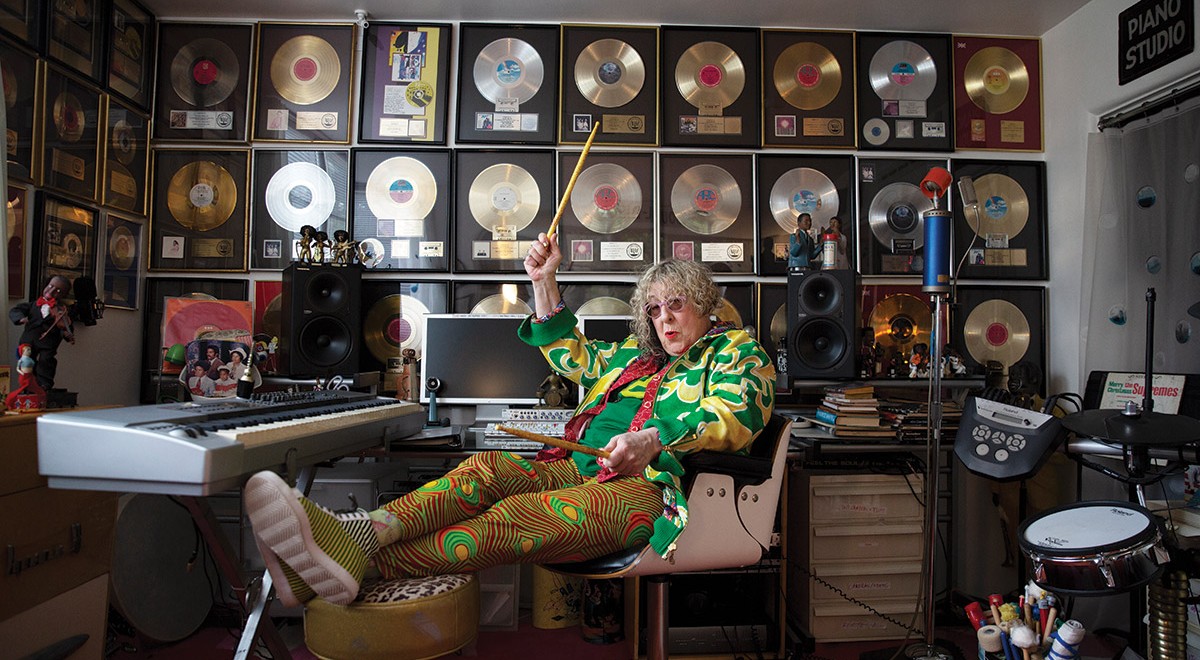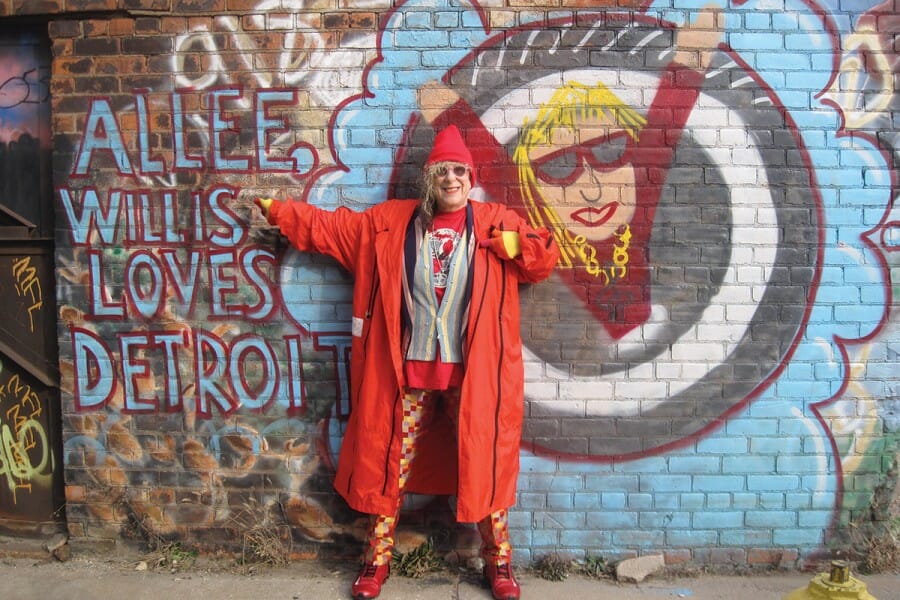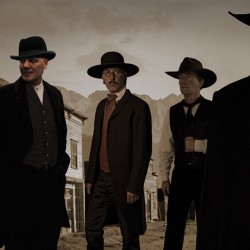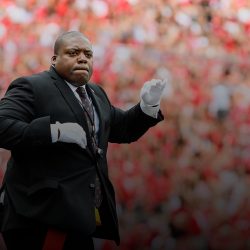
Free to be Allee
Songwriter Allee Willis ’69 defines work as whatever makes her happiest.
When the UW Marching Band asked her to conduct the 2010 Homecoming halftime show, Allee Willis ’69 — the musical mastermind behind the lasting hit song “September” — confesses she had no idea what she was doing.
Though she loves music, she’s had no formal training. And it wasn’t until she walked through the tunnel and onto the field at Camp Randall Stadium, sporting her signature sunglasses and inimitable fashion style, that she realized things had changed — dramatically — since she attended games with her sorority sisters in the late ’60s.
“I’m thinking there will be 12,000 people, which is still pretty overwhelming,” she laughs. “There were 80,000 fans!”
But with the same can-do, devil-may-care spirit that’s marked her professional success and survival for five decades, Willis embraced the moment.
“It was an absolute blast! I have no idea how to read sheet music, so I started flailing my arms,” she says. “And it turned out pretty amazing.”
Willis is a two-time Grammy award winner (for the music and lyrics to Broadway’s The Color Purple and the Beverly Hills Cop motion picture soundtrack) who scored a spot in the Songwriters Hall of Fame in 2018. She’s been nominated for a Tony (The Color Purple) and an Emmy (the Friends theme song); sold more than 60 million records; collaborated with everyone from Bob Dylan to James Brown and Cyndi Lauper; and also pursued her passions in painting, sculpture, multimedia design, furniture making, set design, digital video, and social-networking technology.
“I change careers a lot,” she says.
Quirky and candid, Willis has a keen sense about the creative projects that will make her happy — and the courage to say no and move on to something new if they won’t. Just recently, she wrapped a string of one-woman shows and was busy collaborating with pioneering musician Beatie Wolfe and preparing to host another of her legendary parties.
“My parties are performances. They take months of planning, gathering, building, and working on how music fits in,” she explains. “I absolutely love what I do.”
Party, Protest, Participate
Willis’s first step on her winding career path was in advertising, writing copy for record labels after graduating from the UW. The School of Journalism’s academic reputation and the university’s active social life made Wisconsin a clear choice for the Detroit native and pop-culture junkie.
Studying, parties, protests — Willis participated in everything she could during her four years in Madison. She joined Sigma Delta Tau, whose national office named her its Outstanding Alumna last year, and socialized with fellow Carroll Hall residents.
“I started off a sorority girl … and ended up marching and demonstrating,” Willis says. “I knew I was going to a great school at a time of revolution. I got the best of all worlds.”
Although she preferred record shops to live shows, Willis was tuned in to Madison’s music scene and knew of the influential artists on campus just a few years before her, including Boz Scaggs x’66, Ben Sidran ’67, and Steve Miller x’67.
For a music fan from Motown, the next step was obvious: New York City. Within a month of beginning work as a secretary at Columbia Records and its Epic label, she landed a promotion to the advertising department and a chance to work with artists she idolized — Barbra Streisand, Laura Nyro, and Janis Joplin (who passed away shortly after Willis began working there). It was “an incredibly exciting job to have landed directly out of school,” she says.
After a few years, Willis turned her attention from writing liner notes to writing songs, a major leap of faith for someone with a deep devotion to music — and absolutely no experience.
“I jumped in,” she says of her first — and only — album, 1974’s Childstar. “I had never, ever performed before. I had been in one school play, and I literally played a tree. No lines, no nothing.”
Although she didn’t plan on a career in music when she was growing up, Willis says it’s easy now to see how her Detroit childhood helped shape her journey. Her informal musical education consisted of sitting on the front lawn of Berry Gordy’s Motown Records, soaking up the sounds that would become groundbreaking hits as they seeped through the walls.
Some of Columbia’s other releases overshadowed Childstar, notably Billy Joel’s Piano Man and Bruce Springsteen’s first two albums. Willis calls it a blessing in disguise. It took only four live shows for her to realize performing held no joy for her. In fact, she describes her first show, playing for a crowd of 10,000, as “horrifying.” The record label dropped her a few months later.
Hoping to cheer her up, a friend dragged Willis to a recording session — “the last place you want to be when you lose your own deal,” she says — and unknowingly reignited her career. The singer was Bonnie Raitt, a rare fan of Childstar, who sent Willis home to write her a song. “Got You on My Mind” appeared on Raitt’s 1974 album Streetlights, and Willis hit the road as a backup singer.
Success didn’t come overnight, however. For nearly four years, Willis checked hats at a comedy club and hung posters for a cabaret. Her social circle included singers Barry Manilow, Melissa Manchester, and Bette Midler, whose career was the first to take off. There were days when her only meal came from the backstage green room at Midler’s shows.
“You’re young. You’re excited. You all believe you’re gonna be stars, and you don’t even consider the possibility it won’t happen,” she says. At the beginning of 1978, Willis was living on food stamps. By the end of the year, she had sold 10 million records.
604
songs/titles are registered under Willis’s name in the BMI database.
60 million
copies of her hits have been sold.
1992
saw the debut of willisville, which became the first social network in cyberspace — years before Facebook, MySpace, and Twitter.
September to Remember
Her big break occurred when a mutual friend introduced Willis to her all-time favorite singer, Earth, Wind & Fire founder Maurice White, who called on her to help the band flesh out the lyrics to a new song. “September” reached number one in the Billboard R&B singles chart, and the band asked her to cowrite music and lyrics for their next album. I Am went double platinum and included “Boogie Wonderland,” a hit Willis loves because of its unique arrangement and complex lyrics. “That was just an incredible gift,” she says.
Once Willis broke through with one of the coolest groups on the planet, the calls kept coming. She was writing more than 100 songs a year at one point. “I was a machine,” she says. But she quickly grew bored and knew that she couldn’t keep it up indefinitely.
Years of artistic torment followed. “Writing a song is very much dependent on who I am working with,” Willis explains. “If it’s someone I love, who’s talented, I can have a great time. But a lot of the time, they need help writing and basically you’re a babysitter. I spent a lot of my career doing that. It’s why I got on so many records, but it made me absolutely hate songwriting.”
Willis also tired of seeing her male peers promoted to producer roles, while many women with equal success, or more, were denied the same opportunities.
“Women have never had a big voice in music,” she says. “More power started to come with Beyoncé and Taylor Swift, but before that, you had to fight for every inch.”
In the 1980s, Willis tried to rally her fellow songwriters to unionize, but there wasn’t enough interest from other writers, male or female, in going up against decades of tradition.
“I just wanted to express my creativity. The easiest way to do that was to just start doing things other than music,” she says.
Early Adopter
Willis continued to write, but chose her collaborators more carefully.
In 1991, she became fascinated by technology and the boundless possibilities of the budding internet. She spoke at the first Digital World conference in 1992, along with the founders of AOL and Intel. In 1997, she addressed Congress on the topic of artists’ rights in cyberspace. And she spent years developing willisville — an early social network populated with fanciful fictional characters who acted as guides into cyberspace and interacted with humans — more than a decade before the invention of Facebook or Twitter. (She says of today’s social media platforms: “They’re a necessary evil. There are incredible things that have come out of them, and hideous things.”)
Also an early adopter of eBay, Willis discovered some of her now-favorite kitsch collectibles on the online auction website. Vintage clocks, collectible lunchboxes, and decorative ceramics fill her historic pale pink home in Los Angeles (known as Willis Wonderland, after her hit “Boogie Wonderland”) and populate her Allee Willis Museum of Kitsch website, ostensibly one of the largest collections of kitsch in the world.
Last year, Willis wrapped one of her most ambitious projects, a tribute to her much-loved and often maligned hometown of Detroit. Willis and collaborator Andrae Alexander wrote “The D” and recorded more than 5,000 people at 70 singalongs across the city. Aside from $15,000 raised in an online crowdfunded campaign, Willis financed the entire six-year project.
“I will do anything for Detroit,” she says.
The feeling is mutual. Her hometown honored her with a Distinguished Achievement Award in 2018. “To be acknowledged by the Detroit Music Awards, which is a major thing in Detroit, was as thrilling as the [Songwriters] Hall of Fame,” she says. “This whole year has been completely unexpected and amazing.”
Willis is an enterprising entertainer seeking out what makes her, and the world, happy — and having a blast doing it.
“I’m always excited. That’s the key. You gotta remain curious,” she says. “And if it’s not working for you … get off your ass and do something else.”
Wendy Hathaway ’04 is a writer living in the Madison area.
Published in the Spring 2019 issue




Comments
No comments posted yet.